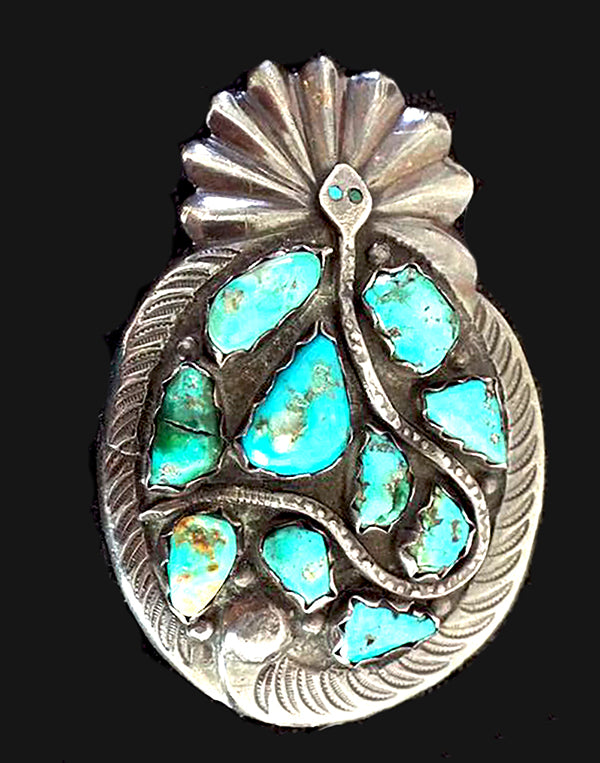While snakes do not qualify as a popular Zuni design they are interesting for that reason—why were they not more desirable? Only two jewelers are known for their use of snakes; Dan Simplicio and Effie Calavaza who was an in-law through Dan’s sister who married Frank Calavaza. Dan Jr. said his father got the idea for snakes from Navajos he worked with in the Kennedy shop. Dan made his snakes with serpent shaped heads [they say that all vipers and poisonous snakes have triangular heads], textured the body, and added rattles.
The Juan Calavaza piece illustrated here has a snake with a slightly pointed head, but later work, and the distinctive Effie C. examples have a perfectly round head, sometimes with the front squared off.

In the book Navajo Taboos you will find more than twenty taboos relating to snakes. In a strange little article by Charles F. Lummis printed in Out West Magazinein 1896 he tells this story: “A very good friend of mine, the best silver smith among the Navajos, made to my order once a bracelet in [the] shape of a rattlesnake.” Though the Pueblos revere such serpents, “…to the Navajos he is “bad medicine”—and his people beat poor Chit-chi nearly to death, destroyed his hut and made [a]way with the obnoxious symbol.” Pretty harsh.
Though taboos today, whether Navajo or Zuni, are weakening and dropping by the wayside, snakes are still dangerous. While Navajos will go out of their way to avoid the snakes, to Zunis they are representatives of the lightning, and thus rain.
Item 165 in the Wallace catalog is a belt buckle attributed to Teddy Weahkee dated 1935. It is a veritable snake pit of serpents, coiling and writhing around like impossible mazes. One coils around the entire buckle and the other four are so twisted and convoluted it is hard to follow the bodies. The stones are cut in such a way they look like snakes as well, judging from the coral inlaid eyes.

Once the stones are set the artist can’t heat up the piece again. For Effie and Juan Calavaza this was not a great problem. Just leave the heads of the snakes sticking up and out of the way. The silver has just been annealed; heating the metal up makes it soft. Once the stones are in place just bend the snake heads down on the turquoise.

There are many pieces attributed to Dan Simplicio just because they have nuggets or coral, including pieces by Robert and Bernice Leekya. But so far as I know, the Simplicio leaf is his alone. His pieces, and the one by Teddy Weahkee, show master craftsmen at work. The writhing snakes are hardly attached to the plate at all. I have not actually handled these creations, but the photos are pretty clear. The amazing ring has Dan’s leaf.

These incredible snakes were largely unattached when the stones were put in place, making the writhing, wriggling snakes a separate creation. The makers had to put them in position without marking the soft silver with a steel pliers. Both Teddy and Dan had spent significant time out in the world, so they probably ignored any taboo, which accounts for the small number of reptiles in Zuni jewelry.


